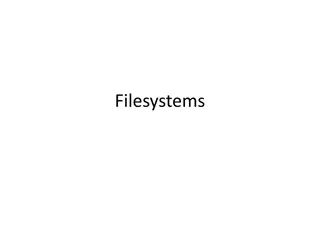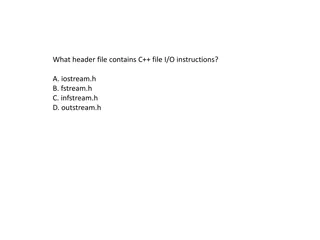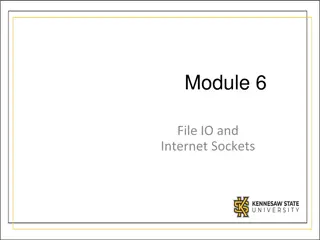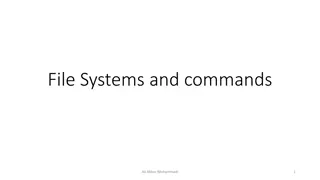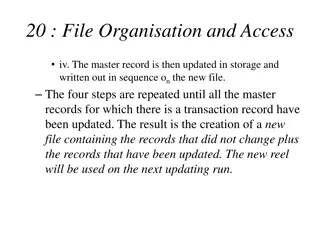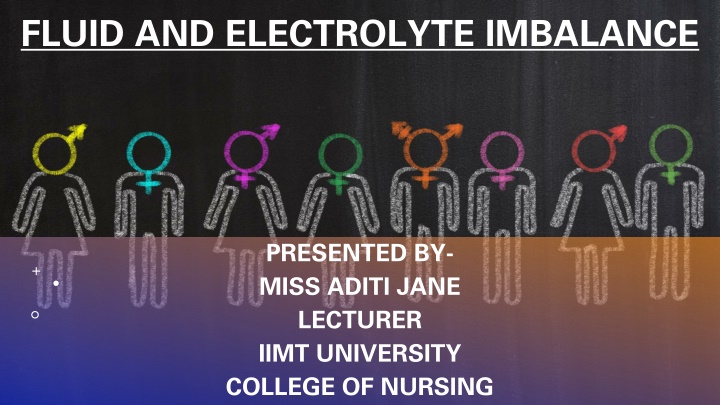
Fluid and Electrolyte Imbalance in Nursing Education
Learn about the important concepts of fluid and electrolyte imbalance as presented by Miss Aditi Jane, lecturer at IIMT University College of Nursing. Explore the distribution of body fluids, electrolytes in body fluids, mechanisms controlling fluid and electrolyte movement, osmosis and diffusion, fluid imbalance, abnormalities in fluid regulation, risk factors for fluid volume deficit, and degrees of dehydration.
Download Presentation

Please find below an Image/Link to download the presentation.
The content on the website is provided AS IS for your information and personal use only. It may not be sold, licensed, or shared on other websites without obtaining consent from the author. If you encounter any issues during the download, it is possible that the publisher has removed the file from their server.
You are allowed to download the files provided on this website for personal or commercial use, subject to the condition that they are used lawfully. All files are the property of their respective owners.
The content on the website is provided AS IS for your information and personal use only. It may not be sold, licensed, or shared on other websites without obtaining consent from the author.
E N D
Presentation Transcript
FLUID AND ELECTROLYTE IMBALANCE PRESENTED BY- MISS ADITI JANE LECTURER IIMT UNIVERSITY COLLEGE OF NURSING
Body fluids are distributed in two distinct area- Intracellular flui9d (ICF) 40% body weight Extracellular fluid (ECF) 20% body weight Interstitial fluid- 15% body weight Plasma- 5% body weight
MECHENISM CONTROLLING FLUID AND ELECTROLYTE MOVEMENT Diffusion Facilitated diffusion Active transport Osmosis Hydrostatic pressure
OSMOSIS- fluids shift through the membrane from the region of low solute concentration to the region of high solute concentration until the solution are of equal concentration. DIFFUSION- a substance to move from an area of higher concentration to one of the lower concentration.
FLUID IMBALANCE FLUID IMBALANCE
ABNORMALITIES IN THE REGULATION OF BODY FLUID Fluid volume deficit n(ECFVD)- dehydration Fluid volume excess- over hydration
EXTRA CELLULAR FLUID VOLUME DEFICIT (ECFVD) A decrease in intravascular and interstitial fluids. It is a common and serious fluid balance that results in vascular fluid volume loss (hypovolemia)
RISK FACTORS Diarrhoea Vomiting Diabetic ketoacidosis Haemorrhage Difficulty in swallowing Severe mentally ill patient
DEGREE OF DEHYDRATION Mild Moderate severe
MILD DEHYDRATION Thirst Reduce appetite Skin flushing Dark coloured urine Dry mouth Fatigue Mild headache Chills dizziness
MODERATE DEHYDRATION Decreased sweating and urination, increase heart rate, respiration and body temperature. Extreme fatigue Muscle cramps Severe headache Nausea Constipation Tingling numbness
SEVERE DEHYDRATION Muscle cramps Vomiting Rapid pulse Temporary blindness Painful urination Confusion Respiratory depression Neuromuscular seizures Chest pain unconsciousness
DIAGNOSTIC EVALUATION Increased osmolarity Increased or normal serum sodium level BUN (more than 25mg/dl) Increased specific gravity or urine
MANAGEMENT Oral rehydration IV fluids Dietary management Nursing management
NURSING MANAGEMENT Measure all fluids that enter and leave the body. Check electrolytes, CBC, and urine specific gravity. Assess for hypotension and weak pulse. Assess respiratory system and tissue perfusion. Check orientation, vision, hearing , reflexes and muscle strength. Check for weight changes Check for skin break down and good oral care
EXTRA CELLULAR FLUID VOLUME EXCESS/ OVER HYDRATION ECFVE increased fluid retention in the intravascular and interstitial spaces
ETIOLOGY Administering fluids rapidly or in large amount Failure to excrete fluids Heart failure Renal disorder Decreased plasma proteins Venous obstruction
SIGN/SYMPTOMS NEUROGENIC Confusion Headache Seizures RESPIRATORY Pulmonary congestion
SIGN/SYMPTOMS CARDIOVASCULAR Increased BP Tachycardia Bounding pulse GASTROINTESTINAL Anorexia nausea
DIAGNOSTIC EVALUATION Decreased osmolarity Decreased or normal serum sodium level BUN (more than 8mg/dl) Decreased specific gravity or urine Decreased hematocrit(less than 45%)
MANAGEMENT ECFVE is treated by the addition of solutes to IV fluids. Use of D5%, 0.45% Nacl will help to correct ECFVE. WHEN THE CAUSE IS WATER EXCESS Oral fluids such as water and soft drinks should be given in addition to water. IV therapy should be monitored every hour. Monitor vitals and IO Weight should be checked daily to measure fluid gain or loss
ACID/ BASE The body normally maintains a steady balance between acid produced during metabolism and bases that neutralize and promotes the excretion of the acid, many health problems lead to acid base imbalance. Patient with DM, COPD, kidney disease frequently develop acid-base imbalance.
ACID BASE REGULATION The body metabolic processes constantly produce acids. These acid must be neutralized and excreted to maintain acid base balance. Normally the body has three mechanism by which it regulates acid-base balance to maintain the arterial ph- 7.35 and 7.45. Buffer system respiratory system Renal system
BUFFER- reacts immediately RESPIRATORY- respond minutes and reaches maximum effectiveness in hours RENAL- takes 2-3 days to respond maximally
CLASSIFICATION Respiratory imbalance It affects carbonic acid concentration Metabolic imbalance It affects the base bicarbonate
RESPIRATORY ACIDOSIS It is a clinical disorder in which the PH is less than 7.35. PaCo2 (partial pressure of Co2) is greater than 42mmhg. It may be either acute or chronic. CAUSES Elevated plasma level Elevated carbonic acid Acute pulmonary oedema Impaired respiratory muscles
CLINICAL MANIFESTATION Increased pulse Increased respiratory rate Increased BP Cerebrovascular vasodilation Increased intra cranial pressure Feeling of fullness in head
MEDICAL MANAGEMENT PHARMACOLOGIC AGENT Broncho dilators Antibiotics Anti-coagulant PULMONARY HYGIENE MEASURE Adequate hydration Mechanical ventilation
RESPIRATORY ALKALOSIS It is a clinical condition in which the arterial PH is more than 7.45 and paCo2 is less than 38mmHg. CAUSES Hyperventilation Anxiety Hypoxemia Decreased serum bicarbonate level Cerebral tumors
CLINICAL MANIFESTATION Light headiness due to vasoconstriction Decreased cerebral flow Numbness Loss of consciousness Tachycardia
MEDICAL MANAGEMENT Treatment depends on the underlying cause respiratory alkalosis. Patient is instructed to breath more slowly to allow Co2. Sedatives may be required to relieve hyperventilation in very anxious patient
METABOLIC ACIDOSIS Clinical disturbance characterized by low PH and low plasma bicarbonate concentration Produced by gain of hydrogen ion or loss of bicarbonate
CLINICAL MANIFESTATION Headache Confusion Drowsiness Increased respiration Nausea Vomiting Decreased BP Cold and clammy skin shock
MEDICAL MANAGEMENT Treatment is directed at correcting the metabolic defect. Bicarbonate is administered if the PH is less than 7.1. Serum potassium level is monitored closely.
METABOLIC ALKALOSIS Clinical disturbance characterised by high PH and high plasma bicarbonate concentration. It can be produced by a gain of bicarbonate or a loss of H+ ions. CAUSES Vomiting Gastric suction Cystic fibroid Chronic ingestion of milk
CLINICAL MANIFESTATION Tingling Dizziness Ventricular disturbance (PH increase above 7.6)
MEDICAL MANAGEMENT Sufficient chloride must be supplied for kidney to absorb sodium with chloride Administer sodium chloride fluids Input and output should be monitored.



